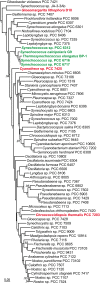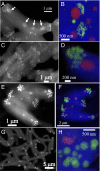Intracellular Ca-carbonate biomineralization is widespread in cyanobacteria
- PMID: 25009182
- PMCID: PMC4121779
- DOI: 10.1073/pnas.1403510111
Intracellular Ca-carbonate biomineralization is widespread in cyanobacteria
Abstract
Cyanobacteria have played a significant role in the formation of past and modern carbonate deposits at the surface of the Earth using a biomineralization process that has been almost systematically considered induced and extracellular. Recently, a deep-branching cyanobacterial species, Candidatus Gloeomargarita lithophora, was reported to form intracellular amorphous Ca-rich carbonates. However, the significance and diversity of the cyanobacteria in which intracellular biomineralization occurs remain unknown. Here, we searched for intracellular Ca-carbonate inclusions in 68 cyanobacterial strains distributed throughout the phylogenetic tree of cyanobacteria. We discovered that diverse unicellular cyanobacterial taxa form intracellular amorphous Ca-carbonates with at least two different distribution patterns, suggesting the existence of at least two distinct mechanisms of biomineralization: (i) one with Ca-carbonate inclusions scattered within the cell cytoplasm such as in Ca. G. lithophora, and (ii) another one observed in strains belonging to the Thermosynechococcus elongatus BP-1 lineage, in which Ca-carbonate inclusions lie at the cell poles. This pattern seems to be linked with the nucleation of the inclusions at the septum of the cells, showing an intricate and original connection between cell division and biomineralization. These findings indicate that intracellular Ca-carbonate biomineralization by cyanobacteria has been overlooked by past studies and open new perspectives on the mechanisms and the evolutionary history of intra- and extracellular Ca-carbonate biomineralization by cyanobacteria.
Keywords: amorphous calcium carbonate; calcification; polyphosphate.
Conflict of interest statement
The authors declare no conflict of interest.
Figures




References
-
- Rosing MT, Bird DK, Sleep NH, Glassley W, Albarede F. The rise of continents—An essay on the geologic consequences of photosynthesis. Palaeogeogr Palaeoclimatol Palaeoecol. 2006;232(2-4):99–113.
-
- Jansson C, Northen T. Calcifying cyanobacteria—the potential of biomineralization for carbon capture and storage. Curr Opin Biotechnol. 2010;21(3):365–371. - PubMed
-
- Golubic S, Lee SJ. Early cyanobacterial fossil record: Preservation, palaeoenvironments and identification. Eur J Phycol. 1999;34(4):339–348.
Publication types
MeSH terms
Substances
Associated data
- Actions
LinkOut - more resources
Full Text Sources
Other Literature Sources
Molecular Biology Databases
Miscellaneous

